Dragonfly nymphs (order Odonata, suborder Anisoptera)

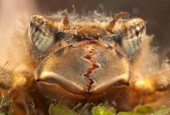


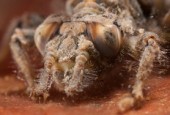
Contained families:
Aeshnidae (Darner dragonflies)
Cordulegastridae (Spiketail dragonflies)
Libellulidae (Skimmer dragonflies)
Corduliidae (Emerald dragonflies)
Gomphidae (Clubtail dragonflies)

Darner dragonfly nymphs
(order Odonata, suborder Anisoptera, family Aeshnidae)
Feeding:
All dragonfly nymphs are predators. Aeshnid nymphs are sensitive to movement and chase their prey.
Habitat:
Nymphs mostly occur in still waters, but can be found in slow flowing parts of rivers and streams as well.
Movement:
They climb around aquatic vegetation and submerged wood.
Size:
Mature nymphs may grow up to sizes around 60 mm.
Life cycle:
Dragonflies undergo incomplete metamorphosis. Their life cycle includes three stages – egg, nymph and adult. Some species produce one generation per year, while others require up to several years for one generation.
Introduction:
As like adult dragonflies, reigning the airspace of insects, their nymphs are among the largest invertebrate predators of freshwater ecosystems.
Characteristic feature of all the nymphs of order Odonata is their extendable lower lip (labium). This „mask“ consists of two connected parts and a pair of labial palps. Palps end with thorns, which are used to grab the prey. In idle state, the mask is composed under the head and covers the mandibles. Darner dragonfly nymphs have a flat lower lip (not shaped into a spoon or scoop).
Aeshnid nymphs have very well developed eyesight, allowing them to chase moving animals. When hunting, the mask is extended by contraction of muscles and body fluids, thereby greatly increasing the reach. The speed of such a thrust can be up to 25 milliseconds and the nymph is able to vanquish a prey even larger than itself. Among other invertebrates, their prey can include small fish, tadpoles and newts.
An elongated and mostly cylindrical body consists of a head, thorax and abdomen. The abdomen terminates with three pointed structures forming a pyramid. Three pairs of segmented legs (each ending with two claws) extend from the thorax. Nymphs occur with mottled patterns in variety of colours including green, brown and yellow.
Anisopteran dragonfly nymphs keep their gills protected in a rectal chamber inside the rear of their abdomen. To breathe, they pump water in and out of their anus. Moreover, this movement can be used to propel themselves rapidly forward and escape the predators. Nymphs shed their chitinous skin (exoskeleton) several times as they grow larger. Wing pads, located on the top of thorax, are developing with the nymph and in the last stage contain precisely folded wings. Fully grown nymphs use plant stems to climb out of the water and emerge into adult dragonflies.
Gallery:
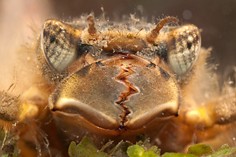
Spiketail dragonfly nymphs
(order Odonata, suborder Anisoptera, family Cordulegastridae)
Feeding:
All dragonfly nymphs are predators. Cordulegastrid nymphs use sit and wait strategy to ambush their prey.
Habitat:
Nymphs mostly occur in running waters, especially in small woodland streams.
Movement:
Most of the nymphal stage they spend partially burrowed in sand and sediments at the bottom.
Size:
Mature nymphs can grow up to sizes around 50 mm.
Life cycle:
Dragonflies undergo incomplete metamorphosis. Their life cycle includes three stages – egg, nymph and adult. Most species require 3 – 5 years for one generation.
Introduction:
Cordulegastridae is the family of dragonflies with typical bottom-living nymphs. Their eyes are relatively small and rise above the body level. The body is elongated, cylindrical and tapered. Nymphs are covered with bristles or tufts of setae. Three pairs of strong segmented legs (each ending with two claws) extend from the thorax. Nymphs do not dig with their front legs but use their hind legs and side to side movements to burrow themselves quickly into the substrate.
Distinctive feature of this family is the large extendable labium. Labial palps are triangular and cover the „face“, thereby forming a mask. Each palp is equipped with large irregular teeth and one movable hook, which are used to hold the prey when it is being devoured. They use sit and wait hunting strategy and consume any type of a prey within their reach.
All anisopteran nymphs breathe underwater by using gills inside the abdomen. Spiketail dragonfly nymphs may remain burrowed and motionless for weeks, while they wait for a prey and reach oxygenated water only with the apex of abdomen above the substrate.
Gallery:
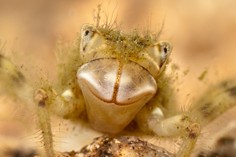 Skimmer dragonfly nymphs
Skimmer dragonfly nymphs
(order Odonata, suborder Anisoptera, family Libellulidae)
Feeding:
All dragonfly nymphs are predators. Libellulid nymphs use sit and wait hunting strategy or actively stalk their prey.
Habitat:
Nymphs can be found in variety of freshwater ecosystems from small ponds and streams to large lakes and rivers.
Movement:
They climb around aquatic vegetation and crawl on the bottom. Some species burrow into the sediments.
Size:
Mature nymphs can grow up to sizes around 30 mm.
Life cycle:
Dragonflies undergo incomplete metamorphosis. Their life cycle includes three stages – egg, nymph and adult. Some species produce one generation per year, while others require up to several years for one generation.
Introduction:
Libellulidae is large and diverse family of dragonflies. Nymphs are found near the banks or in sediments at the bottom of various freshwater ecosystems. Some species are very tolerant to low levels of dissolved oxygen and can be found in warm ponds and marshes with large amounts of nutrients.
Nymphs have relatively short, oval and often flattened bodies. Three pairs of long segmented legs extend from the thorax. The head is nearly always narrower than the abdomen. Sedentary nymphs are squat and look a bit like spiders.
In general, the predators living at the bottom must detect their prey by touch, rather than by sight. They do not need especially large eyes, but longer and sensitive antennae are an asset (in contrast to aeshnid nymphs relying primarily on the eyesight).
Labium is shaped into a scoop or spoon to capture smaller animals. Labial palps possess setae and mutually interlocking rows of small regular teeth. Triangular palps cover large part of the head and chewing mouthparts. When the mask is extended, the palps spread out and grab the prey, which is then tightened back to be crushed by strong mandibles.
Some species are able to propel themselves surprisingly swiftly by pumping water out of their rectal chamber. This movement can be used to escape the predators and even to get closer to a prey.
Nymphs are well camouflaged due to coloration, mottled patterns and sediments on their bodies. Most nymphs are covered in fine hairs (setae), which help to cultivate the layer of algae and detritus, thereby helping to conceal them. Partially burrowed in sediments or hidden in aquatic vegetation are in idle state almost invisible.
Fully grown nymphs use plant stems (or any other vertical objects protruding above the surface) to climb out of the water. However, they may crawl far distance from the water to find a suitable place to emerge into adult dragonflies.
Gallery:
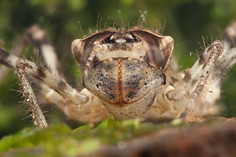 Emerald dragonfly nymphs (Corduliidae)
Emerald dragonfly nymphs (Corduliidae)
(order Odonata, suborder Anisoptera, family Corduliidae)
Emerald dragonflies (Corduliidae) are closely related to skimmer dragonflies (Libellulidae), which are described above.
The nymphs share almost all of their characteristics.
 Clubtail dragonfly nymphs
Clubtail dragonfly nymphs
(order Odonata, suborder Anisoptera, family Gomphidae)
Feeding:
All dragonfly nymphs are predators. Gomphid nymphs use sit and wait hunting strategy to ambush their prey.
Habitat:
Gomphid nymphs are most common in flowing water habitats, but they can be found around the edges of lakes and ponds as well.
Movement:
Most of the nymphal stage they spend partially burrowed in the sand and sediments.
Size:
Mature nymphs can grow up to sizes around 40 mm.
Life cycle:
Dragonflies undergo incomplete metamorphosis. Their life cycle includes three stages – egg, nymph and adult. Most species require 2 – 4 years for one generation.
Introduction:
The way of life and stealthy movements of gomphid nymphs sharply contrast with the aerobatic flight of their adults.
Most species inhabit bottoms of running waters. Nymphs, partially burrowed in sand and sediments, wait patiently until a prey comes close enough to be grabbed with the extendable lower lip. In fast running, rocky streams, the nymphs hide in clefts among the stones, where is a layer of soft silt.
The body shapes of gomphid nymphs vary from elongated to short and oval. They are mostly flattened and broad, which helps to cover in the layer of sediments. Three pairs of short and strong legs extend from the thorax. The legs consist of less segments, than is usual in other dragonfly families (tarsi of the first pair of legs have two segments, while other dragonflies have three). This modification makes the legs more robust for digging.
When the nymphs are burrowed, they get dissolved oxygen by extending the tip of their abdomen above the substrate. The lower lip is flat (not shaped into spoon or scoop) and rests bellow strong mandibles.
Antennae are four-segmented with third segment enlarged, usually cylindrical or nearly oval. The fourth antennal segment is very small and barely visible. Antennae are very sensitive and allow the nymph to detect worm-like prey wiggling in the mud.
When it is time to emerge as adults, most dragonflies climb up the plant stems and use gravity to help them to fall out from nymphal skin. Due to the shape of their legs, gomphid nymphs are bad climbers. They often crawl up the shore or some stone above the water surface and step out of the nymphal skin in nearly horizontal position.
Gallery:










































































































































